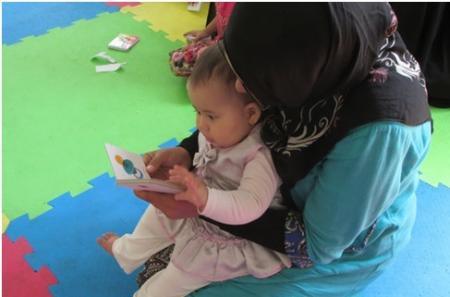
Entering into a house with a white door at Tehran’s Yousefabad neighborhood, Shirin Ahmadian greets me with a welcoming smile into the delightful house of ‘Read with Me’.
Decorated with children’s books, the pleasant atmosphere of the house assures me that it is the right place!
The house of Read with Me is a project to promote book reading and make high quality books accessible for deprived children in Iran, Ahmadian, the public relations manager, told the Tehran Times.
Children should read books
Launched by Iran’s Institute for Research on the History of Children’s Literature in August 2011, the project was initiated by children’s literature researchers Mr. Mohammad-Hadi Mohammadi and Ms. Zohreh Qaeni, Ahmadian said.
“According to studies, reading books for children has a great impact on their lives by feeding their imagination,” Ahmadian explained.
Mohammadi and Qaeni have reviewed children’s literature from ancient to modern times in a ten-volume book titled “The History of Children’s Literature in Iran”.
Talking with children and reading illustrated book for them stimulate their imagination so it is essential for every child in any part of the world, she said.
“Unfortunately low-income families can’t afford buying books and they do not have access to high quality books. So, we try to solve these problems in this project,” she explained.
A sustainable program
The project plans to teach children Persian alphabet and their pronunciations in a creative way as a basic need for reading books.
“We focus on creative education for school-age children with the help of teachers in schools in deprived or remote areas,” Ahmadian said.
She said that the project highlights the importance of ‘basic literacy’ in parts of the country where children speak in dialects other than Farsi.
“For example in Sistan-Baluchestan province, children have problems pronouncing some letters in Persian alphabet,” she explained.
The project holds some workshops for children and their teachers to facilitate learning Persian alphabet in such regions.
She named the Ministry of Education as one of the main supporters of the project.
“The ministry help us getting connected to schools in deprived areas and increase motivation for teachers for cooperation,” she said.
“We hold workshops for teachers during academic year and provide them with a series of high quality books, lesson-plans and related activities.
“Then we have three-month inspections, during which, our experts visit the schools and ask teachers to give us feedback about what was going on,” Ahmadian explained.
She said that teachers read aloud one book for students each week from January to June and they do some activities like theater performance, painting and story writing related to the story they heard.
She said that although the project is flexible in all parts of Iran, the priority is given to deprived and remote areas.
The project is underway in eastern and southeastern provinces of South Khorasan, Sistan-Baluchestan, and Kerman.
Library service planned
“We do our best to acquaint children with the joy of book reading by providing them with books through the year,” Ahmadian said.
She said that the project is aimed to build libraries in the target cities.
“We provide a book package, containing 33 titles of books, for the libraries,” she said.
Up to now, a library has been established in Salakh village located on Qeshm Island in the Persian Gulf for children, she said.
Ahmadian also said that we ask some motivated teachers in different parts of Iran to be their ‘envoy’ and explain other teachers about the plan during coming academic year.
“In this way, we can control expenses of project and native people can help us to be more influential,” she explained.
Reading for newborns
“We hold mom and tot classes in deprived area so that we teach mothers how to read books for their children and right interaction with the baby,” Ahmadian said.
She named Mahmoudabad cultural center in Shahr-e Rey as one of the places in which the classes are held.
“Although many of its population work in brick making kilns, mothers welcome the classes,” she added.
Ahmadian said they teach making cloth books for children during the classes.
“They make cloth books with pieces of cloths in their houses for children and it was so exciting,” she explained.
Be a part of it!
People can contribute to the development of the project by offering donations to a fund named ‘Tavanak’, Ahmadian said.
We need people who are active in designing graphic patterns, launching websites, reading books, and equipping libraries, as well as teachers and theater artists in different parts of the country as well, she concluded.
